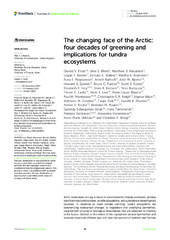The changing face of the Arctic: four decades of greening and implications for tundra ecosystems
Permanent lenke
https://hdl.handle.net/10037/36883Dato
2025-04-10Type
Journal articleTidsskriftartikkel
Peer reviewed
Forfatter
Frost, Gerald V.; Bhatt, Uma S.; Macander, Matthew J.; Berner, Logan T.; Walker, Donald A.; Raynolds, Martha K.; Magnusson, Runa I.; Bartsch, Annett; Bjerke, Jarle W.; Epstein, Howard E.; Forbes, Bruce C.; Goetz, Scott J.; Hoy, Elizabeth E.; Karlsen, Stein Rune; Kumpula, Timo; Lantz, Trevor C.; Lara, Mark J.; López-Blanco, Efrén; Montesano, Paul M.; Neigh, Christopher S. R.; Nitze, Ingmar; Orndahl, Kathleen M.; Park, Taejin; Phoenix, Gareth K.; Rocha, Adrian V.; Rogers, Brendan M.; Schaepman-Strub, Gabriela; Tømmervik, Hans; Verdonen, Mariana; Veremeeva, Alexandra; Virkkala, Anna-Maria; Waigl, Christine F.Sammendrag
Arctic landscapes occupy a nexus of environmental change processes, globally significant soil carbon stores, wildlife populations, and subsistence-based human societies. In response to rapid climate warming, tundra ecosystems are experiencing widespread changes to vegetation and underlying permafrost, coupled with an array of ecological disturbances that are expected to intensify in the future. Declines in the extent of the cryosphere on land (permafrost and seasonal snow) and offshore (sea-ice) raise the question of whether and for how long warmer portions of the Low Arctic will fit established concepts of “what is Arctic,” given the influence the cryosphere has historically had on tundra ecosystem structure and function. The era of spaceborne observation of circumpolar tundra greenness, in the form of the Normalized Difference Vegetation Index (NDVI), has entered its fifth decade and provides foundational information concerning ecosystem conditions and responses to climatic trends, variability, ecological disturbance, and successional processes. Here we review the evolving story of Arctic greening, and synthesize long-term spaceborne records of NDVI, climatic data, field observations, and the knowledge base of Arctic residents to place the last four decades of Arctic environmental change in context, and establish expectations and research priorities for the coming decade. Greenness dynamics display high spatio-temporal variability, reflecting complex interactions of climatic warming and variability, landscape history, ecological disturbance, and other factors. Nonetheless, long-term increases in NDVI—commonly known as “the greening of the Arctic”—remain prominent across large areas in all available long-term spaceborne datasets and align with long-term shifts in vegetation structure documented in disparate Arctic regions. Common shifts reported from the Low Arctic, such as shrubification, generally portend declines in floristic diversity, and shifts in fauna that favor boreal forest species. Despite lingering uncertainties regarding trend attribution and sources of interannual variability, the sequence of record-high circumpolar tundra greenness values observed since 2020 provides strong evidence that Arctic tundra ecosystems have entered a state without historic precedent on timescales approaching a millennium.
Forlag
Frontiers MediaSitering
Frost GV, Bhatt US, Macander MJ, Berner LT, Walker DA, Raynolds MK, Magnusson RI, Bartsch A, Bjerke JW, Epstein HE, Forbes BC, Goetz SJ, Hoy, Karlsen SRK, Kumpula T, Lantz TC, Lara MJ, López-Blanco E, Montesano PM, Neigh CSR, Nitze I, Orndahl, Park T, Phoenix GK, Rocha AV, Rogers BM, Schaepman-Strub G, Tømmervik H, Verdonen M, Veremeeva, Virkkala A, Waigl. The changing face of the Arctic: four decades of greening and implications for tundra ecosystems. Frontiers in Environmental Science. 2025;13Metadata
Vis full innførselSamlinger
Copyright 2025 The Author(s)


 English
English norsk
norsk
